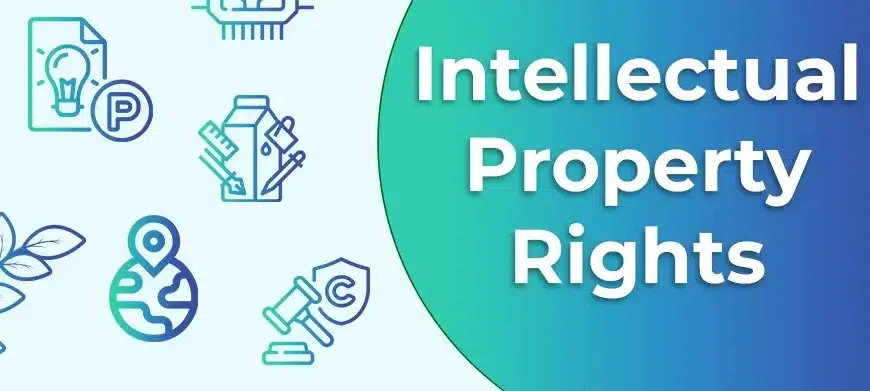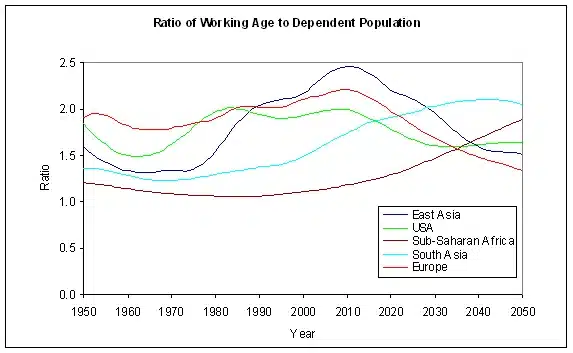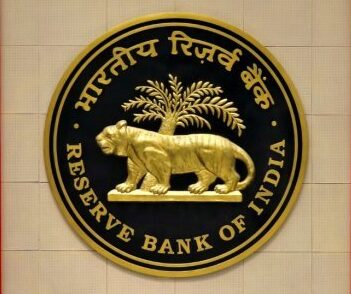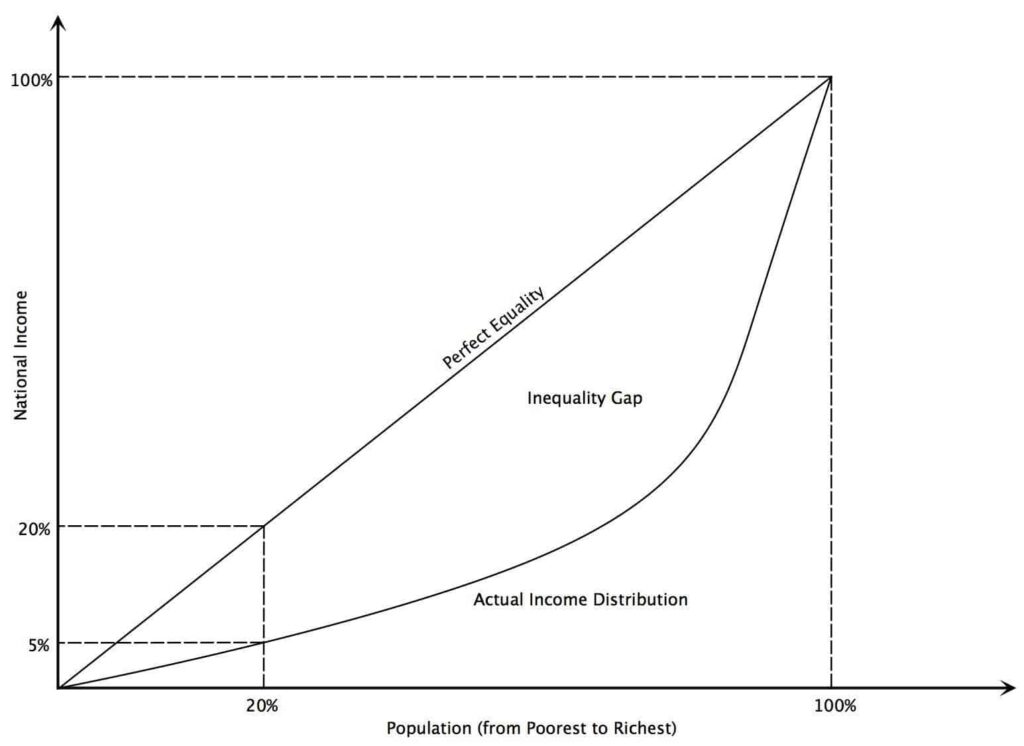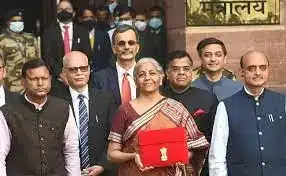Definition of Fiscal Policy
Fiscal policy is the means by which a government adjusts its spending levels and tax rates to monitor and influence a nation’s economy.
- Fiscal policy, in simple terms, is an estimate of taxation and government spending that impacts the economy.
- Fiscal policy is a complimentary strategy to monetary policy (through which a central bank influences a nation’s money supply).
- These two policies are used in various combinations to direct a country’s economic goals.
Objectives of Fiscal Policy
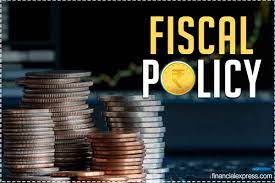
- Fiscal policy primarily aims at economic growth with price stability.
- Among other goals of fiscal policies are: capital formation, resource allocation and redistribution for mitigating inequality.
- It is notable that fiscal policy in a developed country is preoccupied with the problems of business cycle-boom and depression.
- But in a developing economy, tackling business cycle becomes secondary because the prime objective of such economies is capital formation through increased savings and investments in order to achieve high level of economic growth.
- Further, given scarcity of capital and other resources in a developing economy, it is imperative to allocate resources to various sectors of the economy and heads of development judiciously and in line with development priorities. Fiscal policy helps to achieve these goals.
Types of Fiscal Policy
Expansionary fiscal policy
- It is defined as an increase in government expenditures and/or a decrease in taxes that causes the government’s budget deficit to increase or its budget surplus to decrease.
- The aim is to stimulate the economy and ensure consumers’ purchasing power does not weaken.
- It is mostly used in times of high unemployment and recession.
- A government can adopt Expansionary fiscal policy on the following basis:
- Government needs to borrow from domestic or foreign sources.
- Print an equivalent amount of money.
- Draws upon its foreign exchange reserves
Drawbacks of this policy
- The flipside of printing is it leads to inflation.
- If the government borrows too much from abroad it leads to a debt crisis.
- If it draws down on its foreign exchange reserves, a balance of payments crisis may arise.
Contractionary fiscal policy
As the term suggests, this policy is designed to slow economic growth in case of high inflation. The contractionary fiscal policy raises taxes and cuts spending.
- It is defined as a decrease in government expenditures and/or an increase in taxes that causes the government’s budget deficit to decrease or its budget surplus to increase.
Neutral Fiscal Policy
- It is usually undertaken when an economy is in equilibrium. Government spending is fully funded by tax revenue and overall the budget outcome has a neutral effect on the level of economic activity.
Instruments of Fiscal Policy
- Fiscal policy is carried out by the legislative and/or the executive branches of government. The two main instruments of fiscal policy are:
- Government expenditure
- Taxes
- The effect of government expenditures, taxation, and debt on the aggregate economy is of immense importance. The government collects taxes in order to finance expenditures on a number of public goods and services.
Government Expenditure
Public Expenditure
- It is also known as Government expenditure which can be classified under the following heads:
1. Capital Expenditure
- These are those government expenditures which result in the creation of physical or financial assets or reduction in financial liabilities. These include:
- expenditure on the acquisition of land, building, machinery, equipment, investment in shares, and
- Loans and advances by the central government to State and Union Territory governments, PSUs and other parties.
2. Revenue Expenditure
- These are that expenditure incurred for purposes of day to day expenses rather than the creation of physical or financial assets of the central government.
- It relates to:
- Expenses incurred for the normal functioning of the government departments and various services;
- Interest payments on debt incurred by the government; and
- Grants given to state governments and other parties.
- Both Capital and Revenue expenditure are also categorized as plan and non-plan in the budget documents.
- Plan expenditure-relates to Expenditure on Central Plans (the Five-Year Plans) and Central Assistance for State and Union Territory plans.
- Non-plan expenditure-covers a vast range of general, economic and social services of the government.
- The main items of non-plan expenditure are:
- Interest payments
- Defence services
- Subsidies
- Salaries
- Pensions
Government Revenue
Government revenue is classified into:
1. Revenue Receipts
- These are those receipts of the government which are non-redeemable, that is, they cannot be reclaimed from the government.
- They are further divided into tax and non-tax revenues
(i). Tax Revenue
- Tax Revenues consist of the proceeds of taxes and other duties levied by the central government. Tax revenues are an important component of revenue receipts and comprise of following taxes:
- Income tax: Taxes on individual salaries and income.
- Corporate tax: Taxes on firms and corporations.
- Excise duties: Duties levied on goods produced within the country.
- Customs duties: Duties imposed on goods imported into and exported out of India.
- Service tax: Tax levied by the government on service providers on certain service transactions.
- Wealth tax: Charged on the net wealth of the assesse. It is a tax on the benefits derived from ownership of property.
- Gift tax: Tax on the transfer of property by one individual to another while receiving nothing, or less than full value, in return.
- The tax applies whether the donor intends the transfer to be a gift or not. Taxes like wealth tax, gift tax and estate duty (now abolished) have never been of much significance in terms of revenue yield and have thus been referred to as paper taxes.
- The advantage of the tax is that it raises money for governments.
- Critics argue that the tax will result in fewer financial transactions being made, resulting in job losses in financial centres. Others warn that the tax will mean pension funds and savers get less returns, as banks will simply pass the cost of the tax onto their customers.
(ii). Non Tax Revenue
- Non-tax revenue mainly consists of:
- Interest receipts on account of loans by the central government;
- Dividends and profits on investments made by the government;
- Fees and other receipts for services rendered by the government; and
- Cash grants-in-aid from foreign countries and international organisations
2. Capital Receipts
- All those receipts of the government which create liability or reduce financial assets are termed as capital receipts.
- The main items of capital receipts are:
- Loans raised by the government from the public which are called market borrowings,
- Borrowings by the government from the Reserve Bank of India (RBI) and Commercial Banks and other Financial Institutions through the sale of treasury bills,
- Loans received from foreign governments and international organisations,
- Recoveries of loans granted by the central government,
- Small savings (Post-Office Savings Accounts, National Savings Certificates, etc),
- Provident funds, and
- Net receipts obtained from the sale of shares in Public Sector Undertakings
Who sets fiscal policy?
In India, the Union finance minister formulates the fiscal policy.
Effects of Fiscal Policy on Macro Economy
- Fiscal policy affects aggregate demand, the distribution of wealth, and the economy’s capacity to produce goods and services.
- In the short run, changes in spending or taxation can alter both the magnitude and the pattern of demand for goods and services. With time, this aggregate demand affects the allocation of resources and the productive capacity of an economy through its influence on the returns to factors of production, the development of human capital, the allocation of capital spending, and investment in technological innovations.
- Tax rates, through their effects on the net returns to labour, saving, and investment, also influence both the magnitude and the allocation of productive capacity. Fiscal policy also feeds into economic trends and influences monetary policy.
Effects of Fiscal Policy on Consumer Spending
- Lower taxes, everything else being constant, increase households’ disposable income, allowing consumers to increase their spending. The consequences of the cut – how much is spent or saved, and the response of economic activity – depend on the way households make their decisions and on prevailing macroeconomic conditions.
- Whether the tax cut is perceived to be temporary or permanent will influence how much consumers save. A temporary cut will alter households’ disposable income relatively little, and so might have little effect on consumption. If the cut is, instead, perceived to be permanent, then households will perceive a larger increase in their disposable income and so will likely increase their desired consumption by much more than they would if they thought the cut were temporary.
- There is a potential conflict between the use of fiscal policy to stimulate aggregate demand when the economy is operating below potential in the short run and the use of policy to promote longer-run goals for national saving and capital formation to improve future living standards. When there are underutilized economic resources, fiscal stimulus can increase investment. But when the economy is operating near potential, an increase in the public debt might eventually depress private investment, unless the fiscal stimulus is reversed as the economy approaches full employment and utilisation.
- This fiscal drag has the effect of reducing Aggregate Demand and becomes an example of deflationary fiscal policy. It could also be viewed as an automatic fiscal stabiliser because higher earnings growth will lead to higher tax and therefore moderate inflationary pressure in the economy.
Limitations of Fiscal Policy
- There are significant time lags
- Recognition lag: time it takes government to recognize there is a problem
- Decision lag: time required for government to determine most appropriate policy
- Implementation lag: time it takes to figure out how to implement new directives
- Impact lag: time it takes to be felt through multiplier effect
- There are difficulties in changing spending and taxation policies
- It is far easier to increase spending and decrease taxes then to increase taxes and decrease spending
- There is a conflict between levels of government over appropriate policies
- Federal, provincial and city governments may differ on what needs to be done.
- Regional variations
- There is crowding out of private investment
- Increases interest rates
- Reduces amount of funding for private investment
- Deficits impose burden on future generations and Foreign-owned debt removes capital from economy
What is Fiscal Stimulus?
- A fiscal stimulus is a package comprising tax rebates and incentives. It’s used by the government to stimulate the economy and prevent the country from a financial crisis.
- An economic stimulus is the use of monetary or fiscal policy changes to kick start a lagging or struggling economy.
- Example: Governments can adopt practices such as lowering interest rates, increasing government spending and quantitative easing, to name a few, to accomplish this.
- A stimulus package provides tax rebates and boosts spending. As spending increases demand, it creates a situation where employment rises. This, in turn, leads to a rise in income, which proportionately boosts spending. As this continues, the economy recovers from collapse.
- In 2008, at the time of the global financial crisis, the United States had provided a fiscal stimulus that was aimed at increasing the employment rate and boosting the economy.
‘Crowding Out Effect’
This refers to a phenomenon where increased borrowing by the government to meet its spending needs causes a decrease in the quantity of funds that is available to meet the investment needs of the private sector.
- There is general consensus that excess government expenditure financed through borrowing creates many adverse effects in the economy. The concept of crowding out effect indicates one such negative effects of high level of government borrowing.
- The crowding out effect refers to a situation of high government expenditure supported by high borrowing causes decrease in private expenditure. Or in other words, when the government is increasing its expenditure, private expenditure comes down.
- Increased government expenditure and its causality with decreased private expenditure are connected through borrowing.
- If the government is raising its expenditure, it will be indicated by a higher deficit in the budget. For example, in India such rising government expenditure raises fiscal deficit.
- This increased fiscal deficit will be met through borrowing. Government’s borrowing is different than individual/business borrowing in terms of size and impact. This is because government is a big entity and its borrowing will be huge. In effect, high level of government borrowing causes an increase in the market interest rate. Similarly, availability of funds for the private sector will be less due to high level of government borrowing.
Increased interest rate and reduced availability of funds discourages private spending. Or in other words, high government expenditure crowd outs private expenditure.
What Is Fiscal Drag?
- The first point to remember about fiscal drag is that government will get more tax revenue (mainly income tax) at the time of fiscal drag.
- Fiscal drag may happen due to inflation or fiscal policies of the government.
- Fiscal drag is an economic term whereby inflation or income growth moves taxpayers into higher tax brackets. This in effect increases government tax revenue without actually increasing tax rates. The increase in taxes reduces aggregate demand and consumer spending from taxpayers as a larger share of their income now goes to taxes, which leads to deflationary policies, or drag, on the economy.
- Fiscal drag is normally associated with progressive tax rates. Because of progressive taxes, the government will get more taxes when the economy is booming. This also helps slow the rate of increase in demand, reducing the pace of growth, making it less likely to result in higher inflation. Thus fiscal drag is an automatic stabilizer, as it acts naturally to keep demand stable.
- Fiscal drag happens when government’s net fiscal position fails to cover the net savings desires of the private economy, it is also called the private economy’s spending gap. The resulting lack of aggregate demand leads to deflationary pressure, or drag, in the economy, essentially due to lack of state spending or to excessive taxation.
- One cause of fiscal drag is bracket creep, where progressive taxation increases automatically as taxpayers move into higher tax brackets due to inflation. This leads to moderation of inflation, and can be characterized as an automatic stabilizer of the economy.
- Fiscal drag can also be a result of a hawkish stance towards government finances.
- Fiscal drag can be seen as an automatic fiscal stabilizer as it controls a rapidly expanding economy from overheating.
- Also note that fiscal drag means greater tax burden for people. And the greater tax burden can lead to less consumer spending.
Sub-prime mortgage crisis: What was that?
- The term is associated with sub-prime lending.
- Many US banks had lent money to sub-prime borrowers (those borrowers who were rated below the prime borrowers), and these sub-prime borrowers failed to pay back the loans they had taken.
- Loans were given during real estate boom time, but when the bubble burst, banks lost most of their money. Badly affected banks include names like Lehman Brothers, Merril Lynch, and Bear Stearns.
- As many of these banks closed their operations, US went into a period of recession (period of low growth) and the whole world was affected by it.
- US Federal bank ( just like the RBI of India) intervened and it tried everything it could do to prevent further collapse.
- The Federal bank pumped money, they bought many mortgages and gave liberal credit to other banks (Monetary Policy of Federal Bank).
- US government also made significant steps as part of their fiscal policy to control sub-prime crisis and recession. The government announced many tax cuts and started huge public expenditure programs (Fiscal Policy of US Government).
But why is it called “Sub-prime crisis”?
If a person has full capacity to repay loan, we call him “prime”. While the persons who did not have full capacity to repay the loan are called sub-prime. Yet Bank gave them loan and ran into trouble, hence called sub-prime crisis.
What Is a Fiscal Cliff?
- The fiscal cliff refers to a combination of expiring tax cuts and across-the-board government spending cuts that create a looming imbalance in the federal budget and must be corrected to avert a crisis.
- The story of Fiscal Cliff starts with the subprime crisis. US Congress ( similar to Indian Parliament) had passed many laws during the recession period calling for tax cuts, in-order to boost economic activity. But there was a time period specified for these exemptions. Many of these exemptions expired at midnight on December 31, 2012. So period from Jan 1, 2013, was supposed to be a period of high taxes.
- A sudden condition of high taxes and reduced public expenditure after a long period of tax cuts and liberal public expenditure is known as Fiscal Cliff.
Alse refer :


